
News
Behind the Headlines
Two-Cents Worth
Video of the Week
News Blurbs
Articles
Testimony
Bible Questions
Internet Articles (2015)
Internet Articles (2014)
Internet
Articles (2013)
Internet Articles (2012)
Internet Articles (2011)
Internet Articles (2010)
Internet Articles
(2009)
Internet Articles (2008)
Internet Articles (2007)
Internet Articles (2006)
Internet Articles (2005)
Internet Articles (2004)
Internet Articles (2003)
Internet Articles (2002)
Internet Articles (2001)


July 8, 2002
By
Jon Christian Ryter
Copyright 2002 - All Rights Reserved
To distribute this article, please post this web address or hyperlink
![]() n
1996 the Clinton Administration announced that the federal government
was going to redesign the United States greenback in order to make counterfeiting
American currency more difficult. The first bill that was changed was
Benjamin Franklin’s $100 bill.
n
1996 the Clinton Administration announced that the federal government
was going to redesign the United States greenback in order to make counterfeiting
American currency more difficult. The first bill that was changed was
Benjamin Franklin’s $100 bill.  According
to the Bureau of Engraving, the $100 is the most commonly counterfeited
bill outside the United States. The next year Ulysses S. Grant got a makeover,
followed by Andrew Jackson, Alexander Hamilton and Abe Lincoln. Only George
Washington was ignored.
According
to the Bureau of Engraving, the $100 is the most commonly counterfeited
bill outside the United States. The next year Ulysses S. Grant got a makeover,
followed by Andrew Jackson, Alexander Hamilton and Abe Lincoln. Only George
Washington was ignored.
While the $100 bill is the bill of choice
of foreign counterfeiters, American counterfeiters prefer the $20.
The federal government has been floating
the colorful money “trial balloon” since before the first of
the year in order to more accurately gauge the reaction of the American
people to exchanging their greenbacks for what may look more like “Monopoly
money” than real cash. On Thursday, June 20 the 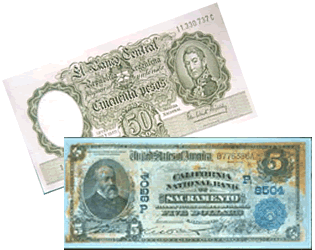 Bureau
of Engraving officially announced that the transition from greenbacks
to a monetary system that more closely resembled the cash used by the
rest of world was soon to be a reality. The transition will begin in the
summer of 2003 with the introduction of a new $20—that, the Bureau
of Engraving assures us—will foil counterfeiters.
Bureau
of Engraving officially announced that the transition from greenbacks
to a monetary system that more closely resembled the cash used by the
rest of world was soon to be a reality. The transition will begin in the
summer of 2003 with the introduction of a new $20—that, the Bureau
of Engraving assures us—will foil counterfeiters.
Of course, that is what the government said
when they created the high tech hologram and new magnetic threads in the
off-centered bills we’ve been using since 1996. Either the technology
used in the new greenbacks we carry in our billfolds and handbags was
not as good as Uncle Sam said it was—or the U.S. Treasury has a much
different reason  for
discarding the American greenback at this time.
for
discarding the American greenback at this time.
While the government’s spin suggests
that by adding “subtle background colors” they will successfully
foil any counterfeiter, the Bureau of Engraving pointed out that adding
color is not a security feature. In point of fact the “colorful”
currencies used by our neighbors to the South and our allies in Europe
and Asia are much more easily counterfeited than the new, “off-center”
American greenbacks with the concealed holograms, magnetic threads and
hidden watermarks that are now in circulation. The “colorful money”
spinmeisters point out that after the Civil War the United States, to
get rid of the Union script “fiat money” stigma of the greenbacks
that were introduced by Lincoln during the Civil War (and paid for by
Lincoln’s illegal income tax to ward off efforts by Treasury Secretary
Salmon P. Chase to create a new central bank in the United States), some
banknotes were so colorful that they were dubbed “rainbow notes”
by the public. What they failed to point out or acknowledge was the ease
by which the “rainbow notes” were counterfeited forced the government
to recall them and return to the security of the greenback.
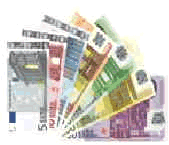 The
Bureau of Engraving has defended the decision to reintroduce “rainbow
notes” by claiming that the colors would help people identify the
different denominations much the way color denotes the denomination of
the Euro. Each Euro, from 1 to 500 has a distinct color with no two bills
utilizing the same tones.
The
Bureau of Engraving has defended the decision to reintroduce “rainbow
notes” by claiming that the colors would help people identify the
different denominations much the way color denotes the denomination of
the Euro. Each Euro, from 1 to 500 has a distinct color with no two bills
utilizing the same tones.
The arguments offered by the U.S. government
and the Bureau of Engraving for changing the general appearance of the
American currency at this time are deceitful since Uncle Sam is attempting
to sell the American people a bill of goods for a very self-centered reason.
All of the currencies of all the nations in the world (except Canada whose
currencies closely emulated the American dollar) are extremely colorful.
To most “world citizens” money is colorful and contains large
photos of the current leaders or historic figures. In the minds of the
IMF and the Fed, if you want the second and third world nations to accept
the American dollar as legal tender in their nations, the transition to
dollarization will be easier to achieve if the American dollar at least
partially resembles their current national currencies.
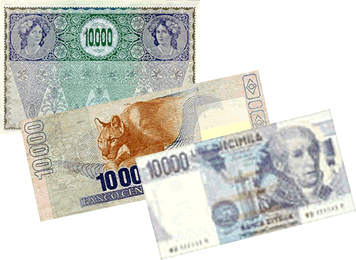 The
International Monetary Fund [IMF], the World Bank and the U.S. Federal
Reserve System, working in tandem with the United Nations to ultimately
achieve a fluid global economy utilizing a single global monetary unit,
had originally planned to begin dollarizing the currencies of Central
and South America at the end of this year as a condition for allowing
those nations to participate in an expanded North American Free Trade
Agreement [NAFTA]. (This is the part of the globalist plan to create five
regional currencies before merging them into a single global monetary
unit somewhere between 2005 and 2007.) The “single America”
agreement will be called the Western Hemisphere Free Trade Agreement.
George W. Bush was supposed to meet with the leaders of the nations of
Central and South
The
International Monetary Fund [IMF], the World Bank and the U.S. Federal
Reserve System, working in tandem with the United Nations to ultimately
achieve a fluid global economy utilizing a single global monetary unit,
had originally planned to begin dollarizing the currencies of Central
and South America at the end of this year as a condition for allowing
those nations to participate in an expanded North American Free Trade
Agreement [NAFTA]. (This is the part of the globalist plan to create five
regional currencies before merging them into a single global monetary
unit somewhere between 2005 and 2007.) The “single America”
agreement will be called the Western Hemisphere Free Trade Agreement.
George W. Bush was supposed to meet with the leaders of the nations of
Central and South 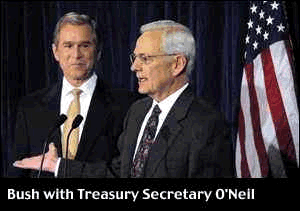 America
at a remote, difficult-to-reach location in northern Canada in February
of this year (to discourage disruptive demonstrators from showing up).
Instead of going to Canada, Bush visited France, Germany and Russia...and
then paid personal visits to several South American leaders who are expected
to dollarize their currencies in exchange for American jobs—as even
more American industrial plants shut their doors in the United States
and export their entire facilities to Central and South America. But before
American industry is willing to invest in these human capital-rich nations
to the South, they want to make sure that the economies—and the currencies—of
those nations are stable.
America
at a remote, difficult-to-reach location in northern Canada in February
of this year (to discourage disruptive demonstrators from showing up).
Instead of going to Canada, Bush visited France, Germany and Russia...and
then paid personal visits to several South American leaders who are expected
to dollarize their currencies in exchange for American jobs—as even
more American industrial plants shut their doors in the United States
and export their entire facilities to Central and South America. But before
American industry is willing to invest in these human capital-rich nations
to the South, they want to make sure that the economies—and the currencies—of
those nations are stable.
While the United States has agreed to dollarize
the currencies of Central and South America, our friends and trading partners
in the Americas, based in part on Argentina’s
experience, and in part because of America’s massive $112.5 trade
deficit, the volatility of the stock market and the drastic slump in consumer
sales in the United States, are not eager to be “dollarized.”
Added to their fears is an American unemployment rate of 6.2%—the
highest level since 1994. Those two fiscal nightmares, colliding at the
same time, have impacted the US stock market and the American dollar in
the international currency market. First, anticipated tax revenue (based
on America’s average household incomes) is off by 40%, creating a
budget shortfall for the Bush Administration and wiping out almost half
of the $1.2 trillion surplus (that really never existed in the first place).
That means thousands of American families that were earning incomes before
NAFTA earned far less last year (if they had any earnings at
all).  That also means that billions of dollars in consumer products that
were manufactured in the United States for consumption by Americans remained
in the manufacturers warehouses as the American consumers, with less discretionary
income to spend, purchased cheap goods from communist China and from the
slave labor nations in the Asian rim as America’s trade deficit increased
18.3% during the last quarter.
That also means that billions of dollars in consumer products that
were manufactured in the United States for consumption by Americans remained
in the manufacturers warehouses as the American consumers, with less discretionary
income to spend, purchased cheap goods from communist China and from the
slave labor nations in the Asian rim as America’s trade deficit increased
18.3% during the last quarter.
(Note: The importation of Asian goods into the United States over the past decade has pretty much destroyed the manufacture and sale of US made softgoods, electronics and other durable goods in this country.
The net result for America’s premiere
manufacturers from 1994 to 1997 was has plummeting stock values with America's premiere branded goods suddenly being produced in the Asian rim nations).
As employment plummeted in the United States due to NAFTA’s job drain
to Canada and Mexico, unemployment skyrocketed in the United States as stock prices even higher than the ;number of Americans who lost their jobs. At this moment, discounting the fact that the Dept. of Labor does not include jobless workers who no longer qualify for umemployment benefits in their statistics, nor do they include unemployed people who give up looking for jobs that no longer exist..
As Americans have learned since the collapse
of Enron and the threatened collapse of MCI-Worldcom, Corporate America’s
financial shape is not as rosy pink as Wall Street made it appear. Creating
the utopian’s dream of a global economy has had, and will continue
to have, long term consequences for the advantaged nations. They will
become disadvantaged as the jobs which supplied generational financial
security for America’s communities are suddenly and surreptitiously
given to the human capital of the emerging nations. As jobs leave the
United States like 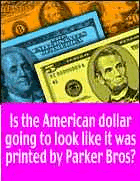 water
through a sieve pandemic unemployment results. With fewer customers available
to buy American-made consumer products, sales in the retail sector necessarily
had to fall. Declining retail sales (further compounded by increased buying
by American consumers of cheap foreign goods) necessarily results in declining
revenue and shrinking profits for those manufacturers who remained headquartered
in the United States.
water
through a sieve pandemic unemployment results. With fewer customers available
to buy American-made consumer products, sales in the retail sector necessarily
had to fall. Declining retail sales (further compounded by increased buying
by American consumers of cheap foreign goods) necessarily results in declining
revenue and shrinking profits for those manufacturers who remained headquartered
in the United States.
Tragically the migration of America’s
jobs is needed by the transnational industrialists to protect their corporate
bottom lines.
Over the past four decades American industrialists have watched their
profits shrink to nothing because America (and the other industrialized
nations) have become nothing more than “replacement markets”
for existing consumers because there are not enough “first time”
buyers available to sustain Corporate America’s growth needs. The
United States has reached a product saturation level of 99.999%. Productivity
in America’s industrial plants has to be deliberately curbed because
there is no market for the consumer products that could be created. As
a result, America’s factories produce goods at 48% of the capacity.
Added to that dilemma is the increasing demand of American workers for
company-paid fringe benefits. Lengthy vacations, stock options, enhanced
retirement programs, health care and life insurance paid for by the employer,
and workplace regulations mandated by the federal government combined
with unemployment insurance costs add substantially to the amount Corporate
America is obligated to pay for each employee on their payroll.
The hidden costs management assumes to utilize
the human capital of the United States is the reason the transnationalist
industrialists urged the redefinition of wealth based on human capital
in the mid-1990s. “National wealth” (for the purpose of borrowing
from the IMF or the World Bank) in the 21st century will be gauged not
in terms of a nation’s capital assets, natural resources or mineral
wealth but by the availability of people to purchase the products created
in the global work place.
In other words, for the capitalistic global
market economy to continue to grow in the 21st century new customers must
be found to purchase the products created by the transnational industrialists
since the industrialized nations, due in part to abortion-on-demand, are
no longer replacing the population they lose through normal attrition.
Those new consumers reside in the population-rich nations of the world:
Mexico, Central and South America, Africa, India, Pakistan, Indonesia,
China and the other Asian rim countries. The problem is that while an
abundance in human capital exists in these nations, those populations,
if employed, have incomes of less than $1,000 per year—and in many
cases, less than $200 per year. In most third world nations the available
labor pool can’t even afford to pay for basic shelter and nourishment.
They have no discretionary income with which to purchase “luxury”
items like a second pair of shoes, a second pair of trousers, or a jacket
heavy enough to protect them from inclement weather.
For
the transnational corporations to create the utopian global economy they
need to grow their companies and protect their bottom lines, they must
provide jobs for the unemployed masses in the third world who have been
earmarked as the new consumers of the 21st century. They are the human
capital of the international bankers and transnational job providers.
They have already been designated not only as the new consumers but the
new taxpayers of the next three decades. But first, they need a steady
job—your job.
And, that’s the rub. The transnational
industrialists who brought their factories to their third world colonies
early in the 20th century and the American industrialists who financed
the industrial growth of the third world nations at the end of the Empire
Age at the conclusion of World War II learned, much to their dismay, that
when the former European colonies declared their freedom from their colonial
overlords, “freedom” was short-lived in these new nations. In
most instances, even before freedom could be sampled, despots overthrew
the new governments and totalitarian dictatorships—either fascist
or communist—were formed. The capital investment the industrialists
made in the emerging economies of those nations was lost. As the economies
of those third world nations collapsed, the factories, without markets
to sell their wares, closed their doors. The capital equipment needed
to turn the gears of progress lay idle, rusting into piles of worthless
scrap metal over the next three or  four
decades. Countless billions of dollars of capital expenditures were lost
by the transnational industrialists who learned that before they could
afford another costly social experiment in the third world they needed
to control the economies of those nations.
four
decades. Countless billions of dollars of capital expenditures were lost
by the transnational industrialists who learned that before they could
afford another costly social experiment in the third world they needed
to control the economies of those nations.
Since Amschel Meyer Rothschild so prophetically
said during the 19th century: “Give me the power to coin the money
and I care not who controls the reins of government,” the money barons
of the world have learned that adage was “truth” in its purest
form.
Learning hard economic lessons during the
post-war years, the transnational industrialists (who no longer profess
allegiance to any nation), will not relocate their factories—and
our jobs—to the emerging economies of the second and third world
until they know their capital investments in those economies are secure.
Using
the World Bank and the IMF to leverage second and third world nations
requiring loans, the international banking community began forcing those
nations to “dollarize” their currencies as a both a condition
of the loan and a condition of securing favorable trade concessions from
the United States. Argentina’s experience, however, soured our Western
Hemisphere neighbors on the notion of pegging their monetary system on
the American dollar (since the dollar is used in Argentina as gold was
used in America when the United States was on the gold standard) since
it prevented Argentina from printing more currencies when the need for
money arose. This led to Argentina robbing the pension funds not only
held by the Argentine government but the industries of Argentina as well.
Bankrupt, Argentina is now looking for a major bailout. To get it—and
jobs from America—the Argentine government must agree to convert
their currency from the Argentine peso to the American dollar. The IMF,
the World Bank 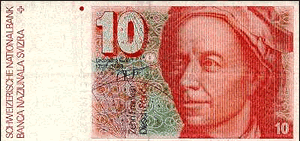 has
demanded that, as a condition of participation by all Central and South
American nations in the forthcoming Western Hemisphere Free Trade Agreement,
those nations must agree to convert their national currencies to the
America dollar. However, there has been a reluctance on the part of all
of these nations—as there was with the States of Europe who resisted
the Euro—to replace their national monetary systems with the American
dollar since the dollar is controlled by the private bankers who own the
United States Federal Reserve System. Each of these nations know that
whomever controls their monetary system ultimately controls them. What
the transnational money barons believe is a mistrust of the American greenback
(because it looks so different from their own currencies) is, in reality,
an inherent mistrust for the motives of the international bankers who
are making these demands on them. The fear, which is spurring a communist
renewal around the world, is that the transnational industrialists and
international bankers are attempting to usurp the sovereignty of all of
the governments of the world in order to line their own pockets. And,
of course, that is precisely what they are attempting to do. That is the
core objective in any free enterprise market economy. National borders
have always served as barriers to trade—and to the profits sought
by the bankers, the industrialists and the global businessmen who peddle
the wares manufactured throughout the world.
has
demanded that, as a condition of participation by all Central and South
American nations in the forthcoming Western Hemisphere Free Trade Agreement,
those nations must agree to convert their national currencies to the
America dollar. However, there has been a reluctance on the part of all
of these nations—as there was with the States of Europe who resisted
the Euro—to replace their national monetary systems with the American
dollar since the dollar is controlled by the private bankers who own the
United States Federal Reserve System. Each of these nations know that
whomever controls their monetary system ultimately controls them. What
the transnational money barons believe is a mistrust of the American greenback
(because it looks so different from their own currencies) is, in reality,
an inherent mistrust for the motives of the international bankers who
are making these demands on them. The fear, which is spurring a communist
renewal around the world, is that the transnational industrialists and
international bankers are attempting to usurp the sovereignty of all of
the governments of the world in order to line their own pockets. And,
of course, that is precisely what they are attempting to do. That is the
core objective in any free enterprise market economy. National borders
have always served as barriers to trade—and to the profits sought
by the bankers, the industrialists and the global businessmen who peddle
the wares manufactured throughout the world.
Just as the merchants of Europe understood
at the ends of both World War I and World War II that for the nation-states
of Europe to exist side-by-side in harmony, the national borders that
interfered with free trade would have to be erased, and a single European
nation created in its place. The core problem that existed with the creation
of the European Economic Community was that each “partner nation”
kept their own national currency and with it, sovereignty over both internal
and external affairs. Variations of the EEC were born and died during
the 60 years that have elapsed since the end of WWII. Each failure was
attributed to the lack of a unified currency—and a superior extra-national
government that would deal with multilateral sovereignty issues: those
dealing with international economic, societal and political issues.
Today 15 European nations have surrendered
external sovereignty to the European Union and the Euro has supplanted
their national currencies as legal tender. The Euro is the first of four
or five regional currencies that will replace 185 national currencies.
The “American” dollar (as opposed to the United States dollar)
will be the second of four major regional currencies. (There is a question
of whether there will a fifth currency for Australia, New Zealand, Borneo
and the islands of the South Pacific, or if those nations will become
“Euroized” because of Great Britain’s role in that area—or
if Australia and New Zealand will convert their pounds to the soon-coming
unified Asian or African monetary units.)
It is the view of the money barons behind
the Federal Reserve, the World Bank, the European Central Bank and the
central banks of nation-states of Europe that much of the hesitation by
the governments of Central and South America to accept the “American”
dollar as legal tender (jointly at first, then as a replacement to their
existing national currencies) is due more to the “greenback”
appearance of the American dollar than it is to the risk of the loss of
sovereignty to the United States since the nation-states of Europe who
are member states of the European Union now seem to be prospering more
than they did prior to their admission into the Union.
The task before the bankers is a multifaceted
problem. They must redesign the American dollar to make it appear similar
enough in appearance that the peoples of the Western Hemisphere nations
will readily accept it as their own money.
And because of that view, the American dollar
will slowly be modified to make it more compatible to the mindset of the
consumers in Central and South America and, at the same time, not to adjust
it too dramatically that it is rejected by the American people who are
already very suspicious of the motives of its government.

Copyright © 2009 Jon Christian Ryter.
All rights reserved.


